Today is the Feast Day of Our Lady of Sorrows, one of the strangest titles for the Virgin Mary. Why do we call her that? Because of her “Seven Sorrows.” And what are those? Seven moments in which she was invited to share in her Son’s suffering. Even Protestants who don’t normally have any sort of devotion to Mary should be able to appreciate the Scriptural foundation of this devotion. The Seven Sorrows are…
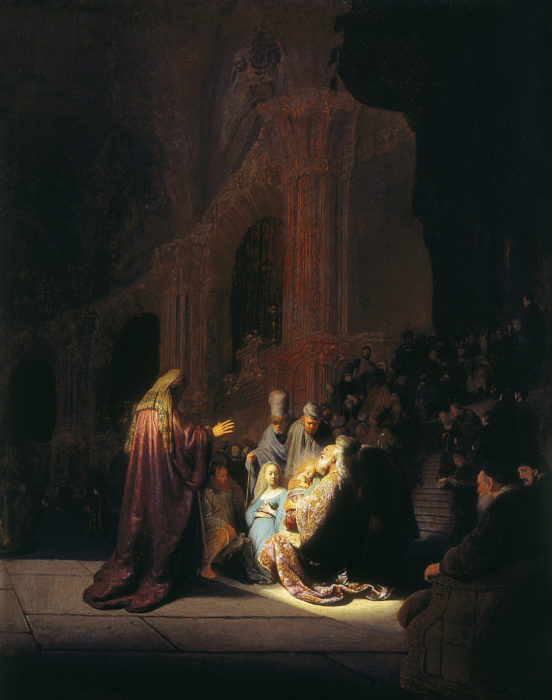
(1) The Prophecy of Simeon
Scripture: Luke 2:25-35,
Now there was a man in Jerusalem, whose name was Simeon, and this man was righteous and devout, looking for the consolation of Israel, and the Holy Spirit was upon him. And it had been revealed to him by the Holy Spirit that he should not see death before he had seen the Lord’s Christ. And inspired by the Spirithe came into the temple; and when the parents brought in the child Jesus, to do for him according to the custom of the law, he took him up in his arms and blessed God and said,
“Lord, now lettest thou thy servant depart in peace,
according to thy word;
for mine eyes have seen thy salvation
which thou hast prepared in the presence of all peoples,
a light for revelation to the Gentiles,
and for glory to thy people Israel.”And his father and his mother marveled at what was said about him; and Simeon blessed them and said to Mary his mother,
“Behold, this child is set for the fall and rising of many in Israel,
and for a sign that is spoken against
(and a sword will pierce through your own soul also),
that thoughts out of many hearts may be revealed.”
At the Presentation, when Joseph and Mary take Jesus into the Temple, a strange man named Simeon takes their child, thanks God for Him, and announces that he’s now ready to die, because he’s finally seen the Messiah… who shall be a Savior for Jews and Gentiles alike. Joseph and Mary “marveled” at what this man said (who wouldn’t marvel about such a strange encounter?), and Simeon blesses them.
So far, the encounter has been odd, but probably largely pleasant. But then Simeon turns his attention to Mary particularly, and tells her of how (a) her Son will be a sign of contradiction “for the fall and rising of many in Israel,” and (b) she herself will experience a sword piercing through her soul. This is perhaps the clearest example of the role Mary is to play in the Passion: the prophecy is that she will suffer alongside of Christ, but that her suffering will be spiritual. While His Body is ripped apart, so will her soul. And Simeon’s prophecy is itself the first of Mary’s sorrows – this strange and terrible foreboding, to a young mom, that something awful is going to happen to her Baby.
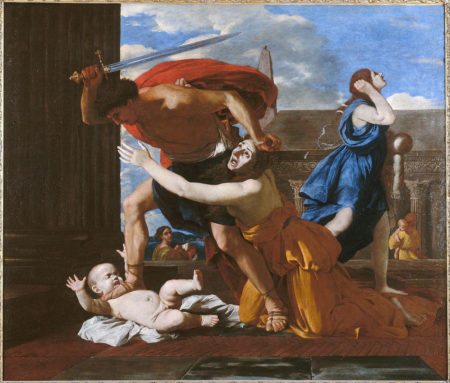
(2) The Flight Into Egypt
Scripture: Matthew 2:13b-18,
Now when they [the wise men] had departed, behold, an angel of the Lord appeared to Joseph in a dream and said, “Rise, take the child and his mother, and flee to Egypt, and remain there till I tell you; for Herod is about to search for the child, to destroy him.” And he rose and took the child and his mother by night, and departed to Egypt, and remained there until the death of Herod. This was to fulfil what the Lord had spoken by the prophet, “Out of Egypt have I called my son.”
Then Herod, when he saw that he had been tricked by the wise men, was in a furious rage, and he sent and killed all the male children in Bethlehem and in all that region who were two years old or under, according to the time which he had ascertained from the wise men. Then was fulfilled what was spoken by the prophet Jeremiah:
“A voice was heard in Ramah,
wailing and loud lamentation,
Rachel weeping for her children;
she refused to be consoled,
because they were no more.”
The second sorrow of Mary happens soon after the first. Her husband awakes from a dream to announce that the King is trying to murder their baby, and that they have to leave home immediately. Maybe you’ve read these words a thousand times, but stop and absorb what it must have been like for Mary and Joseph, who don’t get to flip ahead in the Book to see what happens next.
If that experience wasn’t enough – the terror of being hunted by a powerful and ruthless ruler; and the pain of becoming a refugee, not knowing if you’ll ever see your home again – another pain soon follows. Herod’s men ruthlessly kill all of the infants and toddlers in the area. These would have been the children that Jesus played with. Think about this for a moment from Mary’s perspective: all of her “mom friends” have just had their kids murdered, because Herod was looking for her Child. How does one even process that grief?

(3) The Loss of the Child Jesus in the Temple
Scripture: Luke 2:41-51,
Now his parents went to Jerusalem every year at the feast of the Passover. And when he was twelve years old, they went up according to custom; and when the feast was ended, as they were returning, the boy Jesus stayed behind in Jerusalem. His parents did not know it, but supposing him to be in the company they went a day’s journey, and they sought him among their kinsfolk and acquaintances; and when they did not find him, they returned to Jerusalem, seeking him. After three days they found him in the temple, sitting among the teachers, listening to them and asking them questions; and all who heard him were amazed at his understanding and his answers. And when they saw him they were astonished; and his mother said to him, “Son, why have you treated us so? Behold, your father and I have been looking for you anxiously.” And he said to them, “How is it that you sought me? Did you not know that I must be in my Father’s house?” And they did not understand the saying which he spoke to them. And he went down with them and came to Nazareth, and was obedient to them; and his mother kept all these things in her heart.
The finding of the Child Jesus in the Temple is a joyous event (it’s the Fifth Joyful Mystery, after all), but before there’s a finding, there must be a losing. It’s an experience most parents can relate to: the terror of losing a child in a store or a crowded area, and not knowing where they are. Even worse is to lose a child while on vacation or traveling. Here, Joseph and Mary have lost Jesus in the big city, Jerusalem, where they were staying for Passover. Jesus is 12 by this point, and they’ve already traveled a day’s journey away from Jerusalem before realizing He wasn’t just somewhere else in the pilgrimage group. Without the aid of modern technology, how does one even go about finding a missing child in a city the size of Jerusalem, during one the busiest tourist (well, pilgrimage) season of the year? It’s on Day 3 that they spot Him in the Temple, and only because they know Him well enough to know He’d likely be there that they find Him even that quickly.
There’s a reason that the Holy Spirit chose this as the only event from Jesus’ childhood that’s recorded. Pay attention to that acute sense of separation and loss that Mary would have felt for those three days, and see how they prepared for the three days of separation starting on Good Friday, many Passovers later. Mary gives voice to this pain when she asks Him, “Son, why have you treated us so? Behold, your father and I have been looking for you anxiously.” Jesus’s response is cryptic. It’s literally, “Did you not know that I must be about My Father’s?” and He seems to be intentionally vague as to whether He means “in His Father’s house” or “about His Father’s business.” Mary says nothing back. She just observes that He returns with them and is obedient, and she ponders the meaning of it all.
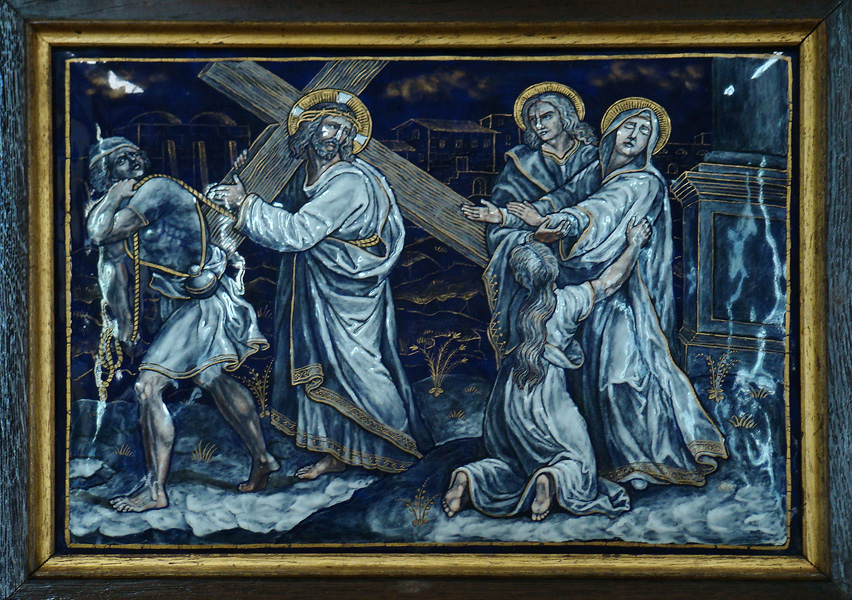
(4) Meeting Jesus on the Way of the Cross
Scripture: Luke 23:26-31,
And as they led him away, they seized one Simon of Cyrene, who was coming in from the country, and laid on him the cross, to carry it behind Jesus. And there followed him a great multitude of the people, and of women who bewailed and lamented him. But Jesus turning to them said, “Daughters of Jerusalem, do not weep for me, but weep for yourselves and for your children. For behold, the days are coming when they will say, ‘Blessed are the barren, and the wombs that never bore, and the breasts that never gave suck!’ Then they will begin to say to the mountains, ‘Fall on us’; and to the hills, ‘Cover us.’ For if they do this when the wood is green, what will happen when it is dry?”
The Virgin Mary and a number of other women are following Jesus to Calvary. His words are perhaps less comforting than ominous. He seems to be telling them that worse days are to come. Jesus speaks of days so dark that they will mourn their motherhood, in what seems to be a reference to the imminent destruction of Jerusalem (70 A.D.) that many of these women would live to see. This terrifying prophecy, coupled with the pain of watching Him struggle under the wood of the Cross, is the fourth of Mary’s seven sorrows.
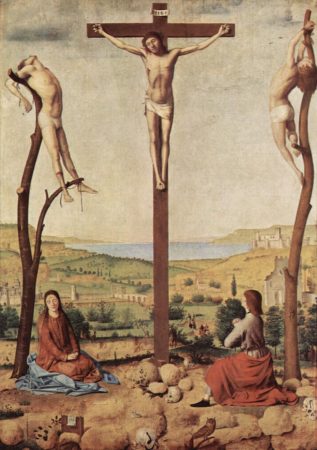
(5) The Crucifixion of Jesus
Scripture: John 19:25b-30,
But standing by the cross of Jesus were his mother, and his mother’s sister, Mary the wife of Clopas, and Mary Magdalene. When Jesus saw his mother, and the disciple whom he loved standing near, he said to his mother, “Woman, behold, your son!” Then he said to the disciple, “Behold, your mother!” And from that hour the disciple took her to his own home.
After this Jesus, knowing that all was now finished, said (to fulfil the scripture), “I thirst.” A bowl full of vinegar stood there; so they put a sponge full of the vinegar on hyssop and held it to his mouth. When Jesus had received the vinegar, he said, “It is finished”; and he bowed his head and gave up his spirit.
While so many others run away or stand at a distance, Mary is there at the foot of the Cross, experiencing the fullness of Good Friday. Her Son is whipped, crowned with thorns, stripped naked, and is slowly being tortured to Death in front of her, while she can do nothing but watch. As she beholds her Son dying, He cries out to her, spiritually entrusting the Apostle John to her care. And then, after suffering one last indignity (being fed vinegar in His thirst), He dies.
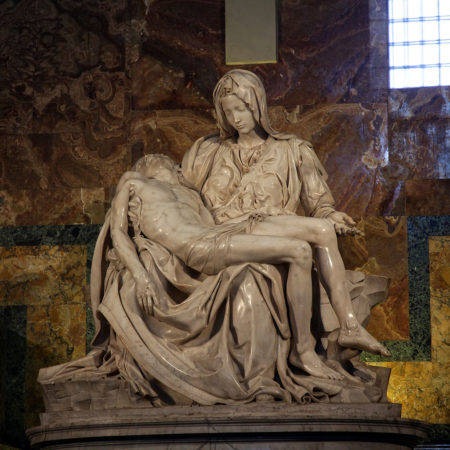
(6) Jesus is Taken Down from the Cross
Scripture: Matthew 27:57-58,
When it was evening, there came a rich man from Arimathe′a, named Joseph, who also was a disciple of Jesus. He went to Pilate and asked for the body of Jesus. Then Pilate ordered it to be given to him.
We are not explicitly told that Jesus is laid in the arms of His Mother, but it seems almost certainly true from Scripture. Why? Because the Body of Jesus is taken down from the Cross, and His Mother Mary is still there, along with the other Galilean women (as we’ll see from Luke 23 momentarily). What’s so striking about the fact that the Virgin Mary and the other Galilean women are still there is that this is now evening, and Jesus died several hours earlier, at about 3 p.m. (Matt. 27:46). These women have apparently just been there for hours, grieving His Death. We know that they then follow Joseph and Nicodemus to the Tomb to watch His Burial. It would be shocking if Mary didn’t want to hold her Son once last time before His Burial.

(7) The Burial of Jesus
Scripture: Luke 23:50-56,
Now there was a man named Joseph from the Jewish town of Arimathea. He was a member of the council, a good and righteous man, who had not consented to their purpose and deed, and he was looking for the kingdom of God. This man went to Pilate and asked for the body of Jesus. Then he took it down and wrapped it in a linen shroud, and laid him in a rock-hewn tomb, where no one had ever yet been laid. It was the day of Preparation, and the sabbath was beginning. The women who had come with him from Galilee followed, and saw the tomb, and how his body was laid; then they returned, and prepared spices and ointments. On the sabbath they rested according to the commandment.
Jesus’ Body is entrusted to Joseph of Arimathea, a dissenting member of the Sanhedrin that just put Jesus to death (of which “one part were Sadducees and the other Pharisees,” Acts 23:6; we’re not told which sect Joseph was in). “Nicodemus also, who had at first come to him by night, came bringing a mixture of myrrh and aloes, about a hundred pounds’ weight” (John 19:39). So the One who spent so much of His time denouncing the Pharisees and Sadducees and teaching His Apostles is buried by these two, after His own Apostles (save John) abandoned Him.
In a sense, we can say that Jesus’ Passion is over, while Mary and the others continue to mourn.
Conclusion
So why do Catholics have a day specially devoted to these Sorrows? Because we take St. Paul seriously when he says (Romans 8:15b-17) “When we cry, ‘Abba! Father!’ it is the Spirit himself bearing witness with our spirit that we are children of God, and if children, then heirs, heirs of God and fellow heirs with Christ, provided we suffer with him in order that we may also be glorified with him.“ We accompany Jesus along the road to Calvary, and to the Tomb, knowing that He will then take us with Him into Glory. As the Collect (one of the first prayers of the Mass) says for today:
O God, who willed that, when your Son was lifted high on the Cross, his Mother should stand close by and share his suffering,
grant that your Church, participating with the Virgin Mary in the Passion of Christ, may merit a share in his Resurrection.
Who lives and reigns with you in the unity of the Holy Spirit, one God, for ever and ever.
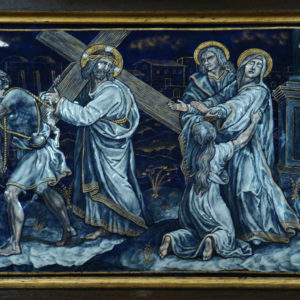
Joe, I have this site bookmarked and believe I’ve checked it a couple times a week since the site began. I’ve found each post to be interesting and/or thought-provoking and/or enlightening. This one’s no exception. Also, the Comments section is often worth reading through, thanks to some seemingly good folks with good perspectives. Appreciate your ability to inform and explain the Catholic faith.
This is my birthday and I’ve always loved this feast. it used to be a very solemn feast in the old rite, and the chants for the propers of the day are very beautiful.
Thank you (again) for another excellent article. I, like Jim Louis above, check-in here several times a week to gain from your spiritual knowledge. I frequently pray the Seven Sorrows of Mary during the Offertory at Mass. I am still outraged at the current “Gala of [c]hurch Fashion”…whatever….that has been allowed to sexualize and mock our Church’s vestments.
The garb that displayed seven daggers over the heart (and ample breasts) of one of the models really gets my back up more than the rest. Satan laughing with delight…
It is a poor church which constantly defines itself by pointing to another and saying, “I am not like that/them”.
There was a fellow in a synagogue once who did the same.
You attend a synagogue? Didn’t realize you were Jewish. Shalom!
I can deduce the powers of your deduction friend, be assured of that.
The greatest sorrow of Mary must be the blasphemous adulation heaped upon her and the role that men invented for her and foisted upon her.
“For there is one God, and one mediator between God and men, the man Christ Jesus”.
Is that clear enough for you?